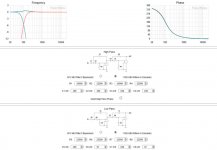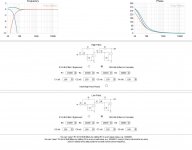You can use this calculator, https://sound-au.com/software/esp-lr13.exe
Thanks. I’ll try it on my PC later.
Dumb questions begin...
There are two pots on each filter "block". P1/P2. Is one pot for the frequency setting and the other for Q? If so, which is which?
Do you want to put the same value C and C/2 capacitors in both the Low Pass and High Pass sections of each channel?
There are two pots on each filter "block". P1/P2. Is one pot for the frequency setting and the other for Q? If so, which is which?
Do you want to put the same value C and C/2 capacitors in both the Low Pass and High Pass sections of each channel?
P1 and P2 makes the resistors adjustable. They set the frequency for each block/stage. This a fully adjustable crossover and the goal is to set everything to suit your speakers not to go for know responses like Linkwitz-Riley, Butterworth, Bessel etc. The potentiometers can be replaced by resistors if you have found your own response.
So those only move the frequency of whatever slope you choose with the jumpers? Not the Q, Not the delay, just the placement of the curve on a range of frequencies? Struggling with the definition of "Fully Adjustable".
Yes, they move the frequency. Q will change if too, the "corner" of the will look different. Butterworth, Linkwitz-Riley and Bessel have a different looking roll-offs. It is the combination of R and C that sets the roll-off for each section. A 4th order have 4 sets of R and C. It can be set in many ways.
So those only move the frequency of whatever slope you choose with the jumpers? Not the Q, Not the delay, just the placement of the curve on a range of frequencies? Struggling with the definition of "Fully Adjustable".
The jumpers set the maximum slope. I believe you will only get this if all the trimmers are set to the same value. Different trimmer combinations will yield different slopes. For example, setting P2 at 1/2 the value of P1 with jumpers set for 24 dB/oct will approximate the L-R slopes which is more gentle than 24 dB/oct.
Roger, Frank that makes a lot more sense. Thanks for the replies!
Should the C and the C/2 values be set the same on the low and high sections of a channel?
Should the C and the C/2 values be set the same on the low and high sections of a channel?
Should the C and the C/2 values be set the same on the low and high sections of a channel?
The C values should be the same for all sections for standard crossovers.
However, different values will probably yield different response curves. I've been playing with the idea of using a lower roll off in the crossover range and have it get steeper further away from it.
Just realized after looking at Post #720 that I need to plot some more points at lower frequencies, so you graphs look nice and smooth. Fixed. 🙂
I see all of the awesome crossover design calculators out there. Is there one that you can actually input the components from a current crossover and have it tell you what that design is actually doing to the signal so you can at least get a good start for settings in the 6-24?
Thank you. If I read 732 posts, I can't remember all of them. Especially if I come up with a new question after I've read it. I DO attempt to use search, but often there really is no good way to query a question. Thank you for putting-up with my Rookieness. 🙂 That app looks awesome. Again, THANK YOU!
But all of that said, what I'm really looking for is a way to understand what a passive crossover does to a signal. Not an active one. Such as the circuit attached.
But all of that said, what I'm really looking for is a way to understand what a passive crossover does to a signal. Not an active one. Such as the circuit attached.
Attachments
Last edited:
And cap values for 45 Hz. ?
Hi Dirk: I came up with 15nF/7.5nF (6.8 actually) for a 45 Hz. target x-over.
Could you -if possible- verify whether my values are correct ?
(Or any one else who may be reading this and may know)
Many thanks,
peter
mrpjasz@gmail.com
Hello bullitt5094,
I have chosen 100nF amd 47nF for my 6-24XO-build for subwoofer use.
My target crossover frequency was around 80Hz.
Greets
Dirk 😀
Hi Dirk: I came up with 15nF/7.5nF (6.8 actually) for a 45 Hz. target x-over.
Could you -if possible- verify whether my values are correct ?
(Or any one else who may be reading this and may know)
Many thanks,
peter
mrpjasz@gmail.com
Hi allhifi. Check your math please. I used 6.8nF in a much higher crossover.
7000/45 = 155.556 or 156nF
7000/45 = 155.556 or 156nF
to allhifi #437
Hello allhifi,
Signal lost is right, for a crossover frequency around 45-50Hz (do you really need that low crossoverpoint?) I get cap values of 150nF (C/2 could be 68nF).
What slope do you want? 24db/octave?
Greets
Dirk
Hello allhifi,
Signal lost is right, for a crossover frequency around 45-50Hz (do you really need that low crossoverpoint?) I get cap values of 150nF (C/2 could be 68nF).
What slope do you want? 24db/octave?
Greets
Dirk
to allhifi #437
I was playing around with Mike Rothachers simulator for a crossover frequency around 45-50Hz (24db-slope).
I would assume you will need caps between 150nF to 220nF.
This was only a short try. I don't know if this would work in real life!!!
So, don't take that pic of the sim below as a recipe!
And I don't know what speakers you want to drive? What the phase response will do....🙄
You can play with the cap values and the resistor values on your own.
CodePen - PASS XO5
And there are also other simulators out there in the web for calculating
Sallen-Key-filters.
Greets
Dirk
I was playing around with Mike Rothachers simulator for a crossover frequency around 45-50Hz (24db-slope).
I would assume you will need caps between 150nF to 220nF.
This was only a short try. I don't know if this would work in real life!!!
So, don't take that pic of the sim below as a recipe!
And I don't know what speakers you want to drive? What the phase response will do....🙄
You can play with the cap values and the resistor values on your own.
CodePen - PASS XO5
And there are also other simulators out there in the web for calculating
Sallen-Key-filters.
Greets
Dirk
Attachments
Ouch .. !
Hi SL: Thanks for that. I wasn;t the one that didthe math but I'll let him know !
Thank you,
Hi allhifi. Check your math please. I used 6.8nF in a much higher crossover.
7000/45 = 155.556 or 156nF
Hi SL: Thanks for that. I wasn;t the one that didthe math but I'll let him know !
Thank you,
These simulations work like glue. Real life will be very close to that, and there's
a pot to take care of any small differences.
Again, no calculated crossover will precisely match real life drivers - some small
adjustment will always make them better in some way.
a pot to take care of any small differences.
Again, no calculated crossover will precisely match real life drivers - some small
adjustment will always make them better in some way.
Oh boy ...
Hi Dirk: Thanks so much for your reply. Looks like some cap values must be changed ! Argghh.
Yes, I believe 45 Hz. is ideal crossing over subwoofer-to-mains (LR/24 db/Oct.)
Withat that said, perhaps it maybe 50/55 Hz but not much higher. To my mind, I wish the main loudspeakers to reproduce all but the last octave in the audio band -it's the number I come up with time/time again. Anything higher and we have the very important sub-harmonics to many music instruments -and voice- being "covered" by the subwoofer and that clearly imposes a 'smearing' of the main's signal.
Thx for your reply,
peter
Hello allhifi,
Signal lost is right, for a crossover frequency around 45-50Hz (do you really need that low crossoverpoint?) I get cap values of 150nF (C/2 could be 68nF).
What slope do you want? 24db/octave?
Greets
Dirk
Hi Dirk: Thanks so much for your reply. Looks like some cap values must be changed ! Argghh.
Yes, I believe 45 Hz. is ideal crossing over subwoofer-to-mains (LR/24 db/Oct.)
Withat that said, perhaps it maybe 50/55 Hz but not much higher. To my mind, I wish the main loudspeakers to reproduce all but the last octave in the audio band -it's the number I come up with time/time again. Anything higher and we have the very important sub-harmonics to many music instruments -and voice- being "covered" by the subwoofer and that clearly imposes a 'smearing' of the main's signal.
Thx for your reply,
peter
- Home
- Amplifiers
- Pass Labs
- DIY biamp 6-24 crossover

